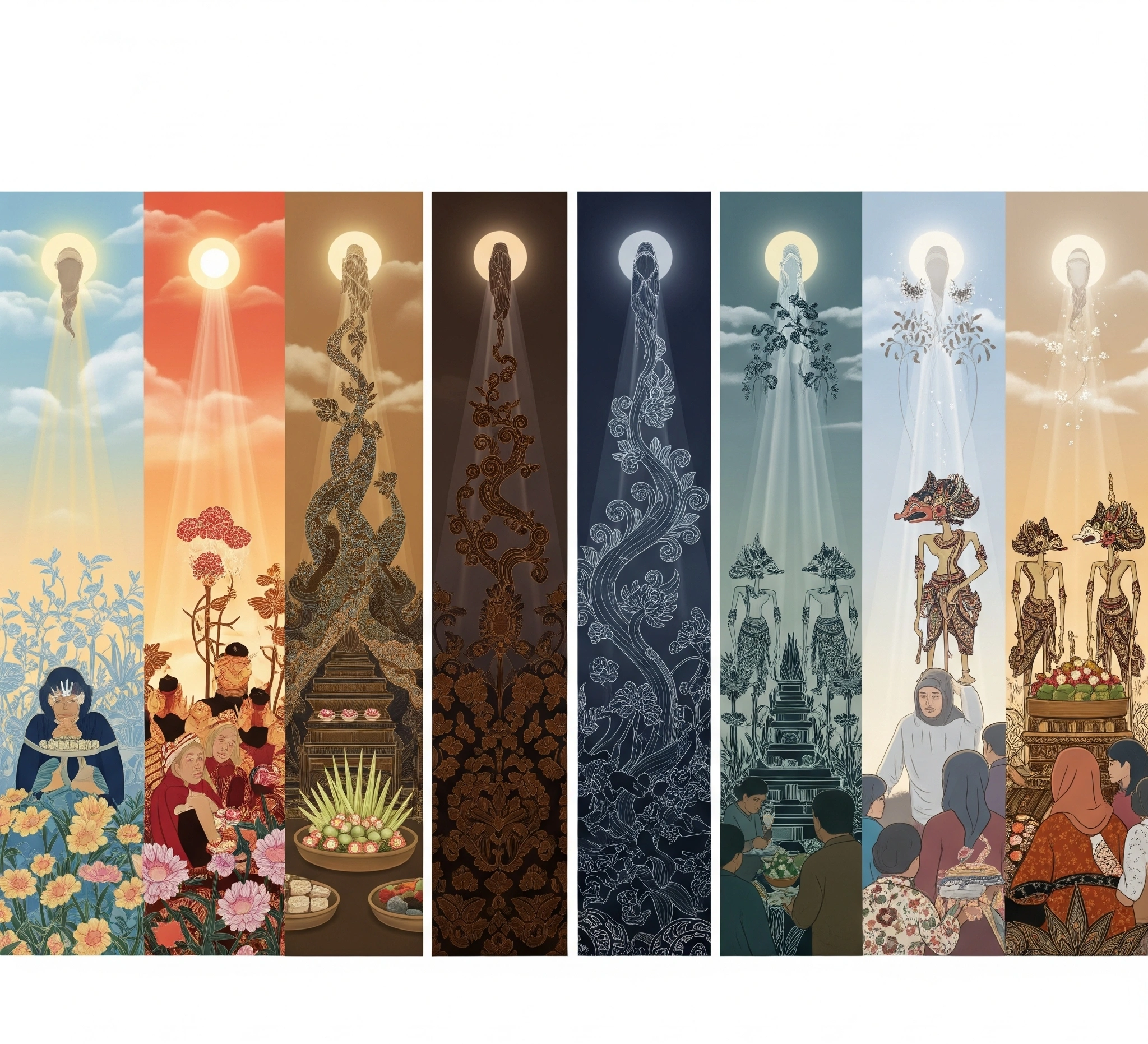The Ancient Whisper: A Timeless Quest for Peace

In the intricate tapestry of human experience, loss is a thread weaving through every culture. Societies navigate grief and honor the departed in unique ways, revealing profound aspects of their beliefs and values. Across the globe, communities develop distinct rituals to support the bereaved and guide the soul. In the heart of Java, Indonesia, a deeply rooted tradition unfolds in the days following a death: a 7-day ritual cycle. This practice, often called *selametan* or mourning rituals, offers solace, continuity, and a framework for understanding the transition from life to the spiritual realm. Understanding this cycle provides insights not only into Javanese culture but also into the universal human need to make sense of mortality and maintain connections with those who have passed.
Kejawen’s Foundation: Deconstructing Its Core Beliefs
The 7-day post-death ritual cycle in Javanese culture is not a rigid structure. Instead, it is a series of interconnected practices. These practices are shaped by a blend of indigenous beliefs, Hindu-Buddhist influences, and Islamic traditions. A core belief underpins these rituals: the soul’s journey after death and the importance of ensuring its peaceful transition to the afterlife. This belief manifests through various ritualistic actions, communal gatherings, and specific offerings.
The “architecture” of this cycle involves several key components:
- **Immediate Post-Mortem Care:** Family members or respected community individuals meticulously prepare the body. This often includes bathing, dressing in clean attire, and applying traditional fragrant oils. This process emphasizes deep respect for the deceased.
- **The Wake (Melayat):** From death until burial, a continuous vigil is typically held at the deceased’s home. Family, friends, and neighbors gather to offer condolences, share memories, and provide practical support. This communal presence provides emotional sustenance and reinforces social bonds.
- **The Burial (Pemakaman):** The burial itself is a significant ritual. It often involves specific processions, prayers (depending on religious affiliation), and symbolic actions. The body’s placement and grave markers also hold cultural significance, reflecting beliefs about the connection between earthly and spiritual realms.
- **The Daily Selametan (Kenduri):** This is the central element of the 7-day cycle. *Selametan* are communal feasts or gatherings held daily at the deceased’s home. They involve prayer recitation (often Islamic), food sharing, and remembrance. These events serve multiple purposes: they provide sustenance to the bereaved family and supporters, create space for collective mourning, and the prayers offered benefit the deceased’s soul.
Diagram illustrating the flow and interconnectedness of Javanese post-death rituals.
The Fabric of Practice: Understanding Kejawen’s Ecosystem
The implementation of the 7-day post-death ritual cycle is deeply embedded within Javanese society’s social and communal structures. It is not solely the immediate family’s responsibility. Instead, it involves a wide network of relatives, neighbors, and community members. This collective participation highlights a strong emphasis on mutual support (*gotong royong*) in Javanese culture, especially during hardship and loss.
The ecosystem of these rituals involves several key actors and processes:
- **The Bereaved Family:** They remain at the center of the rituals, experiencing profound grief while coordinating and hosting the daily *selametan*. They rely heavily on their extended family and community for support.
- **Neighbors and Community Members:** These individuals play a crucial role. They provide practical assistance, such as helping with food preparation, organizing the wake, and offering emotional support. Their presence at the *selametan* tangibly expresses solidarity.
- **Religious Leaders (e.g., Kyai or Modin):** In Muslim Javanese communities, religious leaders often lead prayer recitations during burial and daily *selametan*. They provide spiritual guidance and ensure rituals align with religious customs.
- **Food Preparation and Distribution:** A significant aspect of the *selametan* involves preparing and sharing food. Specific dishes often hold symbolic significance. The act of offering and receiving food reinforces communal bonds and provides sustenance.
- **Information Dissemination:** News of a death spreads quickly through the community. Informal networks and local communication channels often facilitate this. This ensures people are aware and can offer support.
Challenges can arise in modern urban settings where community ties might be weaker. Logistical constraints can also pose difficulties. However, families often strive to uphold these traditions, sometimes adapting them to suit their circumstances.
A community embodies *gotong royong*, offering support during a Javanese mourning ritual.
Experiencing Kejawen: A Practitioner’s Journey
Consider the experience of Ibu Siti and her family in a close-knit village in Yogyakarta. Her elderly father, Bapak Hasan, passed away. Immediately after his death, the community rallied around Ibu Siti. Neighbors came to offer condolences and helped prepare Bapak Hasan’s body for burial. This process was carried out with deep reverence. Throughout the day and night leading up to the burial, people filled the house, reciting prayers, sharing stories about Bapak Hasan, and comforting the grieving family.
The following day, after Bapak Hasan was laid to rest, the 7-day *selametan* cycle began. Each evening, a gathering took place at Ibu Siti’s home. Women from the neighborhood worked together, preparing a communal meal. Each family contributed ingredients or cooked dishes. Local religious figures (Kyai) led Islamic prayer recitations for Bapak Hasan’s soul. Attendees listened respectfully, joining in the final “Amin.” After prayers, everyone shared the food, fostering community and mutual support.
Ibu Siti recalled feeling overwhelmed by grief. However, she also felt deeply supported by her community’s unwavering presence. The daily *selametan* provided a structured framework for mourning. It ensured her family was not alone in their sorrow and that there was a constant reminder of death’s spiritual aspect. The shared meals and prayers offered a sense of continuity and hope during a time of profound loss. This experience, common in Javanese communities, illustrates the crucial role of the 7-day ritual cycle in providing emotional, social, and spiritual support to the bereaved.
Community members provide practical and emotional support to a grieving family during *selametan*.
The Core Revelation: Unveiling Unique Insights
The 7-day post-death ritual cycle in Javanese culture offers profound insights. Its intricate balance between honoring the individual and reinforcing communal solidarity is particularly striking. While the rituals are undoubtedly a period of intense grief and remembrance for the deceased, they simultaneously serve as a powerful mechanism for social cohesion. They also provide crucial support for the bereaved family. This collective mourning underscores the Javanese emphasis on interconnectedness and mutual responsibility within the community.
Furthermore, these rituals’ syncretic nature is fascinating. They blend indigenous animistic beliefs about the soul’s journey with Islamic prayers and communal feasting. This offers a unique perspective on how diverse cultural and religious influences coalesce to form deeply meaningful practices. The focus on daily communal gatherings for a full week highlights a core belief: the soul’s transition requires sustained spiritual support and remembrance from the living. This contrasts sharply with cultures where post-death rituals might concentrate more on the funeral day or specific memorial dates. The extended duration of the Javanese cycle emphasizes the gradual nature of grieving and the ongoing connection between the living and the departed in the immediate aftermath of death.
Practical Wisdom: A Framework for Adaptive Action
The 7-day post-death ritual cycle is a deeply cultural practice specific to Javanese tradition. Nevertheless, understanding its underlying principles offers a valuable framework. This framework helps communities support bereaved individuals and families in any context:
- **Foster Communal Presence:** Encourage community members to offer emotional and practical support to those who have lost a loved one. This can take various forms, from simple presence to offering assistance with daily tasks.
- **Create Structured Opportunities for Remembrance:** Establish regular (though not necessarily daily) opportunities for the community to gather, remember the deceased, and offer condolences. This provides structure during difficult times.
- **Facilitate Practical Support:** Organize ways for community members to provide tangible assistance. This might include meal preparation, childcare, or help with household chores. Such efforts alleviate practical burdens during grief.
- **Respect Cultural and Religious Beliefs:** Acknowledge and respect the bereaved family’s specific cultural and religious customs regarding mourning and remembrance. Offer support in a way that aligns with their traditions.
- **Promote Open Communication and Sharing of Memories:** Create safe spaces for individuals to share memories of the deceased and express grief. This collective sharing can be a powerful tool for healing and remembrance.

A metaphor for healing through community and spiritual connection after loss.
FUTURE VISION & AUTHOR BIO
The 7-day post-death ritual cycle in Javanese culture stands as a testament to the enduring human need for connection, support, and meaning in the face of loss. In a rapidly changing world, these traditions continue to provide a vital framework for navigating grief and honoring the departed. Understanding the intricate architecture and communal ecosystem of these rituals offers valuable insights into the resilience of cultural practices and their profound impact on individual and collective well-being. As societies evolve, the core principles of community support and structured remembrance, exemplified by the Javanese 7-day cycle, remain relevant. They can certainly inform how we collectively care for those experiencing loss across diverse cultural contexts.